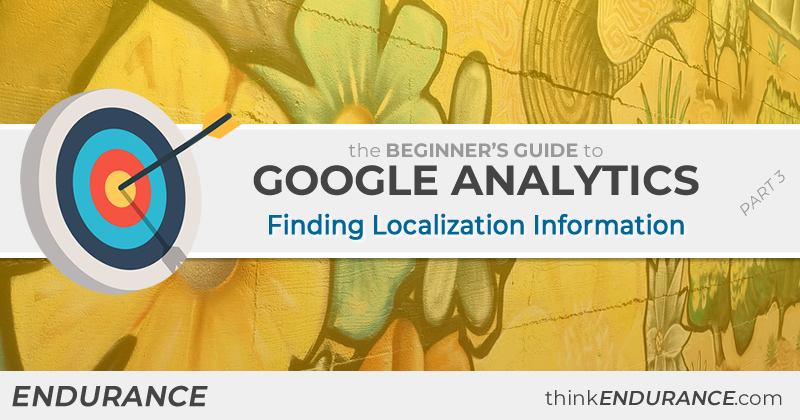
Google Analytics Guide – Part 3: How to View Language and Locale.
Read Time: 3 minutesThis article is for all of those beginning marketers thrust into digital marketing for different geographies or global site awareness. Veterans can even appreciate the views we are going to show as hopefully they’re describe new screens and angles not previously considered. It’s time to explore audience languages spoken and locations users access your site from.
FIRST: Steps to View Website Audience User Languages spoken.
Step 1. Sign in to Google Analytics, Select Audience – Geos.
Sign in to google analytics and select the website and corresponding view. On the left navigation menu, select “Audience,” “Geo,” and then “Language.”
Step 2. Select the date range in which you’d like to view demographic information.
Once you’re on the Language Overview screen, the date range selection will be on the top right of the window. Let’s select Q4 of 2020 as our date range.
Step 3. Update how we compartmentalize the data.
By Default, you will see “All Users” selected. If you go back to part 1 – selecting website traffic audience filtering in Google Analytics – we’ll use that same technique here to filter language by traffic type.
Click on the name “All Users.” A new dialog window appears. Take a moment to take inventory of all the options. You may want to select different options in the future (we’ll have a mobile traffic tutorial later). For now, uncheck “All Users” and check “Direct Traffic,” “Organic Traffic,” “Paid Traffic,” and “Referral Traffic.” NOTE: 4 options selected at once is the max allowed.
Step 4. Change the Goal Filter.
The First Goal (if you have any goals programmed into Google Analytics) will be selected. Take note of the filter to the bottom right that says “Conversions.” For now, lets change that filter to “All Goals.” Later you can adjust accordingly to view specific goals setup. NOTE: this option might not show up for you if you’ve never added goals into Google Analytics.
Step 5. Analyze your Language Data.
It’s important to get familiar with a term called “lang-locale.” As you scroll down through these results, they’re categorized by lang-locale. The first two letters stand for the language, then a hyphen, and the last two stand for the location. In the vast world that is localization, slang, tone, dialect, etc. etc. etc. all matter, and google tries to communicate these difference at a 10,000 foot level.
The first two letters displayed as your scroll down through the data are ISO 639-1 language codes.
en – xx
The “en” in this example stands for English.
zh – xx
The “zh” in this example stands for Chinese.
The last two letters after the hyphen stand for locale. These two letters are based on ISO 3166-1 Alpha-2 two-letter country codes.
en – in | en – us
The “in” in the first example stands for India, combined it means “English spoken in India.”
Whereas the “us” in the second example stands for United States of America, combined it means “English spoken in the USA.”
zh – cn
The “cn” in this example stands for China. Combine is means “Chinese spoken in China.”
You get the picture.
Understanding what can be gained from analyzing Language and Localization in Google Analytics.
At first glance, this data seems very simple, however it really is a powerful tool for marketers in charge of understanding where users are coming from. Recently a Fortune 100 client of ours discovered a vast audience in India simply from this data and spun up an internal project to begin localization to address. I cannot stress enough the importance of natively speaking to your audience and the power it has on conversion.
Leverage the ISO table for language codes and the ISO table for country codes to decipher any combinations you might see in your data.
Next, View Audience Locations in Google Analytics.
Step 1. Assuming your signed into Google Analytics, Select Location.
On the left navigation menu, select “Audience,” “Geo,” and then “Location.”
Step 2. If needed, let’s fix the Date Range, User Buckets, and Goals again.
Change the date range selection, on the top right of the window update the range to Q4 of 2020. Next, uncheck “All Users” and check “Direct Traffic,” “Organic Traffic,” “Paid Traffic,” and “Referral Traffic.” And finally, ensure “Conversions” is changed to “All Goals.”
Step 3. Analyze the Location Data.
In our example, users in India view our site second to users in the United States. Now the numbers might not justify implementing a language tunnel or adjusting content throughout the site, however it could if the numbers were higher. By default you’ll see the top 10 locations for your specific site.
I might also want to gate content based on location or plan an expansion strategy. The power of understanding where users are coming from and how (organic, paid, etc.) is consistently underutilized by marketers.
Where to go from here with Google Analytics?
Part 2 we looked at Simple Demographics in Google Analytics (Age, Gender).
Need help?
We’re starting to get into a lot of Google Analytics data (and we’ve only scratched the surface). This is what we do and it’s not uncommon to need help. Even if it’s simply to ask a question, contact us any time.
















